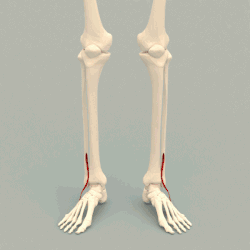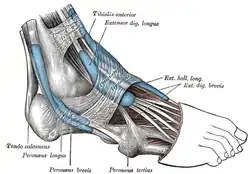Fibularis tertius
| Fibularis tertius | |
|---|---|
 Animation | |
| Details | |
| Origin | distal anterior surface of the fibula also the interosseous membrane |
| Insertion | dorsal surface of metatarsal 5 |
| Artery | anterior tibial artery |
| Nerve | deep fibular nerve |
| Actions | dorsiflexion and eversion of the foot |
| Identifiers | |
| Latin | Musculus fibularis tertius |
| TA98 | A04.7.02.039 |
| TA2 | 2649 |
| FMA | 22538 |
| Anatomical terms of muscle | |
In human anatomy, the fibularis tertius (also known as the peroneus tertius) is a muscle in the anterior compartment of the leg. It acts to tilt the sole of the foot away from the midline of the body (eversion) and to pull the foot upward toward the body (dorsiflexion).
Structure
The fibularis tertius arises from the lower third of the front surface of the fibula, the lower part of the interosseous membrane, and septum, or connective tissue, between it and the fibularis brevis.[1] The septum is sometimes called the intermuscular septum of Otto.
The muscle passes downward and ends in a tendon that passes under the superior extensor retinaculum and the inferior extensor retinaculum of the foot in the same canal as the extensor digitorum longus muscle.[1] It may be mistaken as a fifth tendon of the extensor digitorum longus.[1] The tendon inserts into the medial part of the posterior surface of the shaft of the fifth metatarsal bone.[1]
The fibularis tertius is supplied by the deep fibular nerve.[2][3] In rare cases, it may also be supplied by the common fibular nerve.[2] This is unlike the other fibularis muscles, which are located in the lateral compartment of the leg and are supplied by the superficial fibular nerve, since the fibularis tertius is found in the anterior compartment of the leg.
The fibularis tertius may be absent in humans.[1][4] It may be absent in as few as 5% of people,[4] or as many as 72%, depending on the population surveyed.[1] It is rarely found in other primates, which is one reason its function has been linked to efficient bipedalism.[4]
Function
As a weak dorsiflexor of the ankle joint, the fibularis tertius assists in pulling the foot upward toward the body. It also assists in tilting the sole of the foot away from midline of the body at the ankle (eversion). It is likely to be helpful though not essential in bipedal walking.[4]
Clinical significance
The fibularis tertius may be involved in ankle injuries[1] and may rupture.[5] This is caused by hyperextension.[6]
The fibularis tertius may be imaged using medical ultrasound.[6]
Nomenclature and etymology
Terminologia Anatomica designates "fibularis" as the preferred word over "peroneus.".[7]
The word "peroneus" comes from the Greek word "perone," meaning pin of a brooch or a buckle. In medical terminology, the word refers to being of or relating to the fibula or to the outer portion of the leg.
Other animals
The fibularis tertius muscle in horses originates from the near the lateral condyle of the femur, passes through the extensor sulcus on the head of the tibia, and inserts onto the third metatarsal bone, the third and fourth tarsal bones, and the calcaneus.[8] Rupture of the muscle may cause the Achilles tendon to have a slight dip.[8]
Additional images
 Muscles of the front of the leg (fibularis tertius visible at center left).
Muscles of the front of the leg (fibularis tertius visible at center left). Bones of the right foot (dorsal surface).
Bones of the right foot (dorsal surface). The mucous sheaths of the tendons around the ankle (lateral aspect).
The mucous sheaths of the tendons around the ankle (lateral aspect). Dorsum of Foot. Deep dissection.
Dorsum of Foot. Deep dissection. Dorsum of Foot. Deep dissection.
Dorsum of Foot. Deep dissection.
See also
References
![]() This article incorporates text in the public domain from page 482 of the 20th edition of Gray's Anatomy (1918)
This article incorporates text in the public domain from page 482 of the 20th edition of Gray's Anatomy (1918)
- 1 2 3 4 5 6 7 Salem, Abdel Halim; Abdel Kader, Ghada; Almallah, Amani A.; Hussein, Hoda H.; Abdel Badie, Ahmed; Behbehani, Nadiah; Nedham, Fatema N.; Nedham, Ayesha N.; Almarshad, Reem; Alshammari, Munirah; Amer, Hanine; Hasan, Wafa A.; Alyaseen, Farah A.; Mohammed, Elaf A. (2018-11-01). "Variations of peroneus tertius muscle in five Arab populations: A clinical study". Translational Research in Anatomy. 13: 1–6. doi:10.1016/j.tria.2018.11.001. ISSN 2214-854X.
- 1 2 Zetaruk, Merrilee; Hyman, Jeff (2007-01-01), Frontera, Walter R.; Herring, Stanley A.; Micheli, Lyle J.; Silver, Julie K (eds.), "CHAPTER 32 - Leg Injuries", Clinical Sports Medicine, Edinburgh: W.B. Saunders, pp. 441–457, doi:10.1016/b978-141602443-9.50035-0, ISBN 978-1-4160-2443-9, retrieved 2021-02-23
- ↑ Shapiro, L. E.; Kim, J. H.; Lee, S. J.; Yoo, J. J.; Atala, A.; Ko, I. K. (2016). "16 - In Situ Volumetric Muscle Repair". In Situ Tissue Regeneration - Host Cell Recruitment and Biomaterial Design. Academic Press. pp. 295–312. doi:10.1016/B978-0-12-802225-2.00016-7. ISBN 978-0-12-802225-2.
- 1 2 3 4 Jungers, William L.; Meldrum, D. Jeffrey; Stern, Jack T. (1993-11-01). "The functional and evolutionary significance of the human peroneus tertius muscle". Journal of Human Evolution. 25 (5): 377–386. doi:10.1006/jhev.1993.1056. ISSN 0047-2484.
- ↑ Guard, Charles L.; Peek, Simon F.; Fecteau, Gilles (2018). "12 - Musculoskeletal Disorders". Rebhun's Diseases of Dairy Cattle (3rd ed.). Saunders. pp. 553–604. doi:10.1016/B978-0-323-39055-2.00012-7. ISBN 978-0-323-39055-2.
- 1 2 Dyson, Sue J. (2011). "80 - Other Soft Tissue Injuries". Diagnosis and Management of Lameness in the Horse (2nd ed.). Saunders. pp. 802–806. doi:10.1016/B978-1-4160-6069-7.00080-8. ISBN 978-1-4160-6069-7.
- ↑ FIPAT (2019). Terminologia Anatomica. Federative International Programme for Anatomical Terminology.
- 1 2 Walmsley, John P. (2011). "46 - The Stifle". Diagnosis and Management of Lameness in the Horse (2nd ed.). Saunders. pp. 532–549. doi:10.1016/B978-1-4160-6069-7.00046-8. ISBN 978-1-4160-6069-7.
External links
| Wikimedia Commons has media related to Peroneus tertius. |
- Anatomy photo:15:st-0411 at the SUNY Downstate Medical Center - "The Leg: Muscles"
- PTCentral